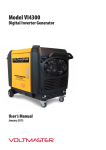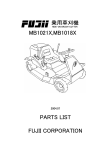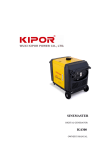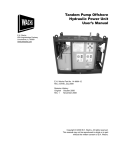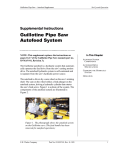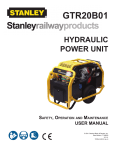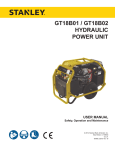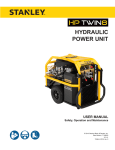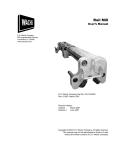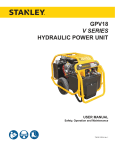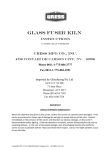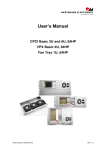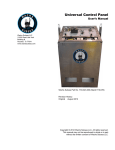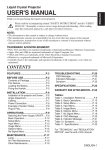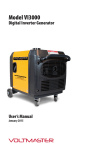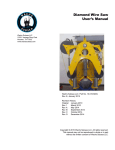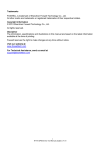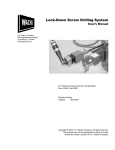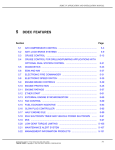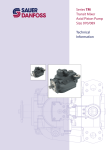Download Manual - EH Wachs
Transcript
84HP Hydraulic Power Unit Wachs Subsea LLC 11050 West Little York, Bldg. N Houston, Tx 77041 1.713.983.0784 www.wachssubsea.com Wachs Subsea LLC Part No: H10-030-000 H10-030-001 (Electric Start) November 2011 Revision History: June 2013 Copyright © 2011 Wachs Subsea LLC. All rights reserved. This manual may not be reproduced in whole or in part without the written consent of Wachs Subsea LLC 84HP Hydraulic Power Unit User’s Manual Part No. H10-030 Wachs Subsea LLC Table of Contents Table of Contents Chapter 1: 84HP Hydraulic Power Unit. . . . . . . . . . . . . . . . . . . . . . . . . . . . . . . . . . . . . . . . . . . 1 Purpose of This Manual . . . . . . . . . . . . . . . . . . . . . . . . . . . . . . . . . . . . . . . . . . . . . . . . . . . . . . . . . 1 How to Use The Manual . . . . . . . . . . . . . . . . . . . . . . . . . . . . . . . . . . . . . . . . . . . . . . . . . . . . . . . . . 1 Symbols and Warnings . . . . . . . . . . . . . . . . . . . . . . . . . . . . . . . . . . . . . . . . . . . . . . . . . . . . . . . . . . 2 Manual Updates and Revision Tracking. . . . . . . . . . . . . . . . . . . . . . . . . . . . . . . . . . . . . . . . . . . . . 3 Equipment Description . . . . . . . . . . . . . . . . . . . . . . . . . . . . . . . . . . . . . . . . . . . . . . . . . . . . . . . . . . 3 System Specifications . . . . . . . . . . . . . . . . . . . . . . . . . . . . . . . . . . . . . . . . . . . . . . . . . . . . . . . . 3 System Components . . . . . . . . . . . . . . . . . . . . . . . . . . . . . . . . . . . . . . . . . . . . . . . . . . . . . . . . . 4 Hydraulic Fluid Overview . . . . . . . . . . . . . . . . . . . . . . . . . . . . . . . . . . . . . . . . . . . . . . . . . . . . . . . 6 Specifications . . . . . . . . . . . . . . . . . . . . . . . . . . . . . . . . . . . . . . . . . . . . . . . . . . . . . . . . . . . . . . 7 Chapter 2: Safety . . . . . . . . . . . . . . . . . . . . . . . . . . . . . . . . . . . . . . . . . . . . . . . . . . . . . . . . . . . . . 9 Operator Safety . . . . . . . . . . . . . . . . . . . . . . . . . . . . . . . . . . . . . . . . . . . . . . . . . . . . . . . . . . . . . . . . 9 Safety Symbols . . . . . . . . . . . . . . . . . . . . . . . . . . . . . . . . . . . . . . . . . . . . . . . . . . . . . . . . . . . . 10 Protective Equipment Requirements . . . . . . . . . . . . . . . . . . . . . . . . . . . . . . . . . . . . . . . . . . . 11 Safety Procedures . . . . . . . . . . . . . . . . . . . . . . . . . . . . . . . . . . . . . . . . . . . . . . . . . . . . . . . . . . 11 Chapter 3: Operating Instructions . . . . . . . . . . . . . . . . . . . . . . . . . . . . . . . . . . . . . . . . . . . . . . 15 Setting Up the Power Unit . . . . . . . . . . . . . . . . . . . . . . . . . . . . . . . . . . . . . . . . . . . . . . . . . . . . . . 15 Start-Up and Operation . . . . . . . . . . . . . . . . . . . . . . . . . . . . . . . . . . . . . . . . . . . . . . . . . . . . . . . . . 19 Engine Starting Tips . . . . . . . . . . . . . . . . . . . . . . . . . . . . . . . . . . . . . . . . . . . . . . . . . . . . . . . . 21 Operating Checks . . . . . . . . . . . . . . . . . . . . . . . . . . . . . . . . . . . . . . . . . . . . . . . . . . . . . . . . . . 22 Electric Starter Set-up and Operation . . . . . . . . . . . . . . . . . . . . . . . . . . . . . . . . . . . . . . . . . . . 26 Chapter 4: Maintenance. . . . . . . . . . . . . . . . . . . . . . . . . . . . . . . . . . . . . . . . . . . . . . . . . . . . . . . 29 Disabling the Starter for Service. . . . . . . . . . . . . . . . . . . . . . . . . . . . . . . . . . . . . . . . . . . . . . . . . . 29 Hydraulic System . . . . . . . . . . . . . . . . . . . . . . . . . . . . . . . . . . . . . . . . . . . . . . . . . . . . . . . . . . . . . 31 Engine Maintenance and Service . . . . . . . . . . . . . . . . . . . . . . . . . . . . . . . . . . . . . . . . . . . . . . . . . 34 Adjusting Pressure Relief Valve. . . . . . . . . . . . . . . . . . . . . . . . . . . . . . . . . . . . . . . . . . . . . . . 34 Fluid Levels . . . . . . . . . . . . . . . . . . . . . . . . . . . . . . . . . . . . . . . . . . . . . . . . . . . . . . . . . . . . . . 37 Air Filters . . . . . . . . . . . . . . . . . . . . . . . . . . . . . . . . . . . . . . . . . . . . . . . . . . . . . . . . . . . . . . . . 37 Spark Arrestor. . . . . . . . . . . . . . . . . . . . . . . . . . . . . . . . . . . . . . . . . . . . . . . . . . . . . . . . . . . . . 39 Air Starter System. . . . . . . . . . . . . . . . . . . . . . . . . . . . . . . . . . . . . . . . . . . . . . . . . . . . . . . . . . . . . 39 Starter Motor Oiler . . . . . . . . . . . . . . . . . . . . . . . . . . . . . . . . . . . . . . . . . . . . . . . . . . . . . . . . . 40 Checking for Leaks . . . . . . . . . . . . . . . . . . . . . . . . . . . . . . . . . . . . . . . . . . . . . . . . . . . . . . . . . . . . 41 Troubleshooting . . . . . . . . . . . . . . . . . . . . . . . . . . . . . . . . . . . . . . . . . . . . . . . . . . . . . . . . . . . . . . 41 Engine . . . . . . . . . . . . . . . . . . . . . . . . . . . . . . . . . . . . . . . . . . . . . . . . . . . . . . . . . . . . . . . . . . . 41 Hydraulic System . . . . . . . . . . . . . . . . . . . . . . . . . . . . . . . . . . . . . . . . . . . . . . . . . . . . . . . . . . 43 Wachs Subsea LLC Part No. H11-024 i 84HP Hydraulic Power Unit User’s Manual Chapter 5: Parts List and Ordering Information . . . . . . . . . . . . . . . . . . . . . . . . . . . . . . . . . . Ordering Information . . . . . . . . . . . . . . . . . . . . . . . . . . . . . . . . . . . . . . . . . . . . . . . . . . . . . . . . . . Ordering Replacement Parts . . . . . . . . . . . . . . . . . . . . . . . . . . . . . . . . . . . . . . . . . . . . . . . . . . Repair Information . . . . . . . . . . . . . . . . . . . . . . . . . . . . . . . . . . . . . . . . . . . . . . . . . . . . . . . . . Return Goods Address . . . . . . . . . . . . . . . . . . . . . . . . . . . . . . . . . . . . . . . . . . . . . . . . . . . . . . Drawings and Parts Lists . . . . . . . . . . . . . . . . . . . . . . . . . . . . . . . . . . . . . . . . . . . . . . . . . . . . . . . ii Part No. H11-024 47 47 47 47 48 48 Wachs Subsea LLC Chapter 1, About the 84HP Hydraulic Power Unit Chapter 1 About the 84HP Hydraulic Power Unit In This Chapter PURPOSE OF THIS MANUAL PURPOSE OF THIS MANUAL HOW TO USE THE MANUAL This manual explains how to operate and maintain the 84HP hydraulic power unit. It includes instructions for setup, operation, and maintenance. It also contains parts lists and diagrams to help you order replacement parts and perform user-serviceable repairs. SYMBOLS AND WARNINGS MANUAL UPDATES AND REVISION TRACKING EQUIPMENT DESCRIPTION HYDRAULIC FLUID OVERVIEW HOW TO USE THE MANUAL This manual is organized to help you quickly find the information you need. Each chapter describes a specific topic on using or maintaining the equipment. Throughout this manual, refer to this column for warnings, cautions, and notices with supplementary information. Each page is designed with two columns. This large column on the inside of the page contains instructions and illustrations. Use these instructions to operate and maintain the equipment. The narrower column on the outside contains additional information such as warnings, special notes, and definitions. Refer to it for safety notes and other information. Wachs Subsea LLC Part No. H10-030 1 84HP Hydraulic Power Unit User’s Manual SYMBOLS AND WARNINGS The following symbols are used throughout this manual to indicate special notes and warnings. They appear in the outside column of the page, next to the section they refer to. Make sure you understand what each symbol means, and follow all instructions for cautions and warnings. This is the safety alert symbol. It is used to alert you to potential personal injury hazards. Obey all safety messages that follow this symbol to avoid possible injury or death. WARNING A WARNING alert with the safety alert symbol indicates a potentially hazardous situation that could result in serious injury or death. CAUTION A CAUTION alert with the safety alert symbol indicates a potentially hazardous situation that could result in minor or moderate injury. This is the equipment damage alert symbol. It is used to alert you to potential equipment damage situations. Obey all messages that follow this symbol to avoid damaging the equipment or workpiece on which it is operating. CAUTION A CAUTION alert with the damage alert symbol indicates a situation that will result in damage to the equipment. IMPORTANT An IMPORTANT alert with the damage alert symbol indicates a situation that may result in damage to the equipment. 2 Part No. H10-030 Wachs Subsea LLC Chapter 1, About the 84HP Hydraulic Power Unit: Manual Updates and Revision Tracking NOTE NOTE This symbol indicates a user note. Notes provide additional information to supplement the instructions, or tips for easier operation. A NOTE provides supplementary information or operating tips. MANUAL UPDATES AND REVISION TRACKING Occasionally, we will update manuals with improved operation or maintenance procedures, or with corrections if necessary. Revised manuals will be available for customers. When a manual is revised, we will update the revision history on the title page and at the bottom of the pages. You may have factory service or upgrades performed on the equipment. If this service changes any technical data or operation and maintenance procedures, we will include a revised manual when we return the equipment to you. EQUIPMENT DESCRIPTION The unit has two hydraulic pumps driven off the Kubota Diesel Engine. Pump one is driven directly off of the main crankshaft is a piston pump capable of 30 GPM @ 3,000 PSI at 2,500 engine RPMs. Pump two is driven off the Kubota Diesel Engine PTO Port and is capable of 12.5 GPM @ 3,000 PSI at 2,500 engine RPMs. Pump one connects to the HPU control panel which divides its flow in to three seperate circuits. Pump Two directly drives the hydraulic systems, hydraulically driven motor, that powers the air to oil, hydraulic cooler. System Specifications • • • • Piston pump providing 40 gpm 151 l/m) hydraulic circuits at 3000 psi (207 bar) and gear pump providing 19.25 gpm (72.9 l/m) at 3000 psi (207 bar) Kubota V3000t diesel engine (84.5 HP @ 2600 rpm) Air start (3/4”-14 taper pipe thread per ANSI B1.20.1) Dry air cleaner Wachs Subsea LLC Part No. H10-030 3 84HP Hydraulic Power Unit User’s Manual • • • • • • • • • • 80 gallon (305 liter) diesel fuel tank ATEX-rated spark arrestor/muffler Safety air shut-off/overspeed valve 114 gallon (436 liter) hydraulic tank Inline flow meters—one each circuit: 30 gpm (114 l/m) and 10 gpm (38 l/m) 0-3000 psi (207 bar) pressure gauges—one each circuit Steel tubular frame with drip pan Lifting eyes at 4 corners Approximate dimensions: height: 60.25” (153 cm) length: 89” (226 cm) width: 45” (114 cm) Approximate weight: 1920 lbs (864 kg) empty; 2400 lbs (1082 kg) with fuel and hydraulic oil tanks full. For detailed information on the diesel engine, see the Kubota engine manual. System Components The following figures illustrate the components of the power unit. 4 Part No. H10-030 Wachs Subsea LLC Chapter 1, About the 84HP Hydraulic Power Unit: Equipment Description Hydraulic oil temp and level gauge Lift Eyes Hydraulic Oil Reservoir Level Gauge Hydraulic oil cooler Fuel Cap (Diesel Only) Control Panel Drain Plug Air Starter Exhaust pipe Diesel Engine Lift Eyes Coolant reservoir Figure 1-1. The photo shows the front view of the HPU, with major components illustrated. Wachs Subsea LLC Part No. H10-030 5 84HP Hydraulic Power Unit User’s Manual Clamp Control Clamp Pressure gauge Cutter Drive pressure gauge System Pressure gauge Feed Pressure Gauge Feed Controls Engine temperature Engine Oil pressure Throttle Engine Shut-Off Bypass-Valve Emergency Shutoff Cutter Drive Control Cutter Drive Hydraulic Flow Feed hydraulic Flow Figure 1-2. HPU control panel. HYDRAULIC FLUID OVERVIEW The performance and life expectancy of your Wachs hydraulic power unit largely depends on the hydraulic fluid used. One of the most important fluid characteristics is viscosity—the “thickness” of the fluid. Viscosity choice is a compromise; the fluid must be thin enough to flow easily but thick enough to seal and lubricate mating surfaces. Fluid temperature greatly affects its viscosity. As the fluid warms it gets thinner (lower viscosity) and as it cools it gets 6 Part No. H10-030 Wachs Subsea LLC Chapter 1, About the 84HP Hydraulic Power Unit: Hydraulic Fluid Overview thicker (higher viscosity). Your Wachs hydraulic power unit has an optimal viscosity range which is listed in the following “Specifications” section. Ambient temperatures, operating loads, and many other contributors affect the fluid’s viscosity. A hydraulic fluid for use in 0° F (-18° C) may not work adequately in 100° F (38° C). Cleanliness of the hydraulic oil is extremely important for the life expectancy of the hydraulic components. Wachs recommends the fluid used to be maintained at ISO Cleanliness Code 19/17/14 per SAE J1165. Establishing a fluid maintenance schedule is the best way of meeting viscosity and fluid cleanliness requirements. Premium grade petroleum-based hydraulic fluids will provide the best performance for your Wachs hydraulic power unit. These fluids typically contain anti-wear additives, rust inhibitors, anti-foaming agents, and oxidation inhibitors. Premium grade fluids carry an ISO VG rating. Synthetic fluids, fluids with viscosity index improvers (ATF or multiviscosity oil), and SAE grade oils maybe used, but their use will require more frequent maintenance intervals and application review in your system. Specifications NOTE: These specifications are guidelines for the hydraulic power unit only. Your hydraulic tools may require more stringent requirements. For example, your tool may limit the operating viscosity range to 85-450 SSU (16 - 95 CSt). Always consult your hydraulic tool manufacturer for hydraulic fluid guidelines. Table 1: Viscosity Data Units Minimum Continuous Viscosity Optimum Operating Viscosity Range Maximum Viscosity at Pressure Viscosity Range Requiring <50% Outlet Pressure SSU 41 55-190 450 470-5000 CSt 9 16-40 95 100-1000 Wachs Subsea LLC Part No. H10-030 7 84HP Hydraulic Power Unit User’s Manual Table 2: Hydraulic Fluid Specifications Specification Range Pour Point -10° F (-23° C) min. Flash Point (ASTM D-92) 340° F (171° C) min. Emulsion Test (ASTM D-1401) 30 minutes min. Oxidation Test (ASTM D-943) 1000 hours min. Rust Inhibition Test (ASTM D-665 A & B) Pass - No Rust Wear Test (ASTM D-2882) 60 mg maximum The following are recommended hydraulic fluids for typical industrial environments: • • • • 8 Citgo AW (anti-wear) 32 Shell Tellus T-32 Shell Tellus S-46 Chevron AW-32 Part No. H10-030 Wachs Subsea LLC Chapter 2, Safety Chapter 2 Safety The Wachs Subsea LLC takes great pride in designing and manufacturing safe, high-quality products. We make user safety a top priority in the design of all our products. In This Chapter OPERATOR SAFETY Read this chapter carefully before operating the hydraulic power unit. It contains important safety instructions and recommendations. OPERATOR SAFETY Follow these guidelines for safe operation of the equipment. • • • • READ THE OPERATING MANUAL. Make sure you understand all setup and operating instructions before you begin. INSPECT MACHINE AND ACCESSORIES. Before starting the machine, look for loose bolts or nuts, leaking lubricant, rusted components, and any other physical conditions that may affect operation. Properly maintaining the machine can greatly decrease the chances for injury. ALWAYS READ PLACARDS AND LABELS. Make sure all placards, labels, and stickers are clearly legible and in good condition. You can purchase replacement labels from Wachs Subsea LLC. KEEP CLEAR OF MOVING PARTS. Keep hands, arms, and fingers clear of all rotating or moving parts. Wachs Subsea LLC Part No. H10-030 Look for this symbol throughout the manual. It indicates a personal injury hazard. 9 84HP Hydraulic Power Unit User’s Manual • • Always turn machine off before doing any adjustments or service. SECURE LOOSE CLOTHING AND JEWELRY. Secure or remove loose-fitting clothing and jewelry, and securely bind long hair, to prevent them from getting caught in moving parts of the machine. KEEP WORK AREA CLEAR. Keep all clutter and nonessential materials out of the work area. Only people directly involved with the work being performed should have access to the area. Safety Symbols This icon is displayed with any safety alert that indicates a personal injury hazard. WARNING This safety alert indicates a potentially hazardous situation that, if not avoided, could result in death or serious injury. CAUTION This safety alert, with the personal injury hazard symbol, indicates a potentially hazardous situation that, if not avoided, could result in minor or moderate injury. NOTICE This alert indicates a situation that, if not avoided, will result in damage to the equipment. 10 Part No. H10-030 Wachs Subsea LLC Chapter 2, Safety: Operator Safety IMPORTANT This alert indicates a situation that, if not avoided, may result in damage to the equipment. Protective Equipment Requirements WARNING Always wear impact resistant eye protection while operating or working near this equipment. For additional information on eye and face protection, refer to Federal OSHA regulations, 29 Code of Federal Regulations, Section 1910.133., Eye and Face Protection and American National Standards Institute, ANSI Z87.1, Occupational and Educational Eye and Face Protection. Z87.1 is available from the American National Standards Institute, Inc., 1430 Broadway, New York, NY 10018. CAUTION Personal hearing protection is recommended when operating or working near this equipment. Hearing protectors are required in high noise areas, 85 dBA or greater. The operation of other tools and equipment in the area, reflective surfaces, process noises, and resonant structures can increase the noise level in the area. For additional information on hearing protection, refer to Federal OSHA regulations, 29 Code of Federal Regulations, Section 1910.95, Occupational Noise Exposure and ANSI S12.6 Hearing Protectors. Safety Procedures All safety requirements listed below are those generally applicable to hydraulically-powered machinery but are not intended to be an all-inclusive list. They are intended as guidelines only and will assist in avoiding risk of injury when followed by qualified, experienced personnel. These Wachs Subsea LLC Part No. H10-030 11 84HP Hydraulic Power Unit User’s Manual precautions should be included in the comprehensive safety program for the particular machinery, equipment, plant or process and overseen by personnel capable of analyzing any hazards associated with operating and maintaining the equipment. WARNING Many types of machinery have parts that may start moving as soon as the hydraulic circuit is filled and pressurized. This could result in injury to personnel or damage to machinery. 1. Return all movable parts of the machinery being operated to their normal startup condition, if possible, before starting unit. 2. Be sure all personnel, product, etc. are clear of machinery before starting hydraulic unit. 3. Check to make sure any hydraulic connections which may have been removed, replaced or disconnected during shut down have been reconnected securely before starting hydraulic unit. 4. Before starting the unit, perform all equipment checks described at the beginning of the operating instructions in Chapter 3. 5. If there are tools or machinery being operated by the HPU that may move when hydraulic flow or pressure are turned off or turned on, block or lock these parts in position before shutting down the hydraulic unit. WARNING Make sure all personnel are clear from the machinery being operated before shutting down the HPU. 6. Shut down the hydraulic unit and relieve pressure from all pressurized accumulators, actuators and lines before removing, tearing down or performing maintenance on any remotely-located actuators, hoses, filters, valves, piping, etc. 7. Any personnel observing or working on or adjacent to hydraulically-powered equipment must never place themselves in a location or position that could produce an injury in the event of: • • • • 12 a hydraulic line failure either with the unit running or shut down; pump or motor failure or; pin-hole leaks in hoses or fittings; movement of machine components during normal operation or resulting from a component malfunction or failure. Part No. H10-030 Wachs Subsea LLC Chapter 2, Safety: 8. Do not inspect hoses and fittings for leaks using your bare hands. A pin-hole leak can inject hydraulic fluid through the skin, with the potential for serious injury. 9. Avoid locating equipment in any environment for which it was not designed and which may create a dangerous operating condition such as an explosive atmosphere (e.g., gas, dust), high heat (e.g., molten metal, furnace), chemicals, extreme moisture, etc. WARNING The injection of hydraulic fluid under the skin can cause serious injury and even result in death. If an injection injury occurs, seek medical treatment immediately. 10. Avoid bodily contact with hydraulic fluids. Some hydraulic fluids may irritate or injure the eyes and skin. Check with your fluid suppliers to obtain this information. 11. Use only Wachs parts and materials when servicing the equipment. Substitute parts or materials could produce a hazardous operating condition. 12. When piping your equipment, use only materials of adequate size and strength to suit the flows and pressures of the system. Consider all safety factors when selecting the strength of materials to allow for shock and over-pressure conditions which could occur. Wachs Subsea LLC Part No. H10-030 13 84HP Hydraulic Power Unit User’s Manual 14 Part No. H10-030 Wachs Subsea LLC Chapter 3, Operating Instructions Chapter 3 Operating Instructions In This Chapter SETTING UP THE POWER UNIT 1. SETTING UP THE POWER UNIT Position the HPU in a flat, well-ventilated location. Use a forklift in the frame channels at the bottom, or a crane attached to all 4 lifting eyes with a 4-point vertical sling. Attach a crane to the lift eyes at all 4 corners 72”(183cm)min. 60 min START-UP AND OPERATION WARNING Use a 72” (183 cm) or longer sling to lift the power unit by the lift eyes. The minimum angle of the sling straps should be at least 60° to provide a 4x safety factor. Reducing the angle will lower the safety factor. Use a forklift in the frame channels Figure 3-1. Lift the HPU at the points shown. Wachs Subsea LLC Part No. H10-030 15 84HP Hydraulic Power Unit User’s Manual 2. Make sure the hydraulic tank oil level is visible in the sight gauge. Figure 3-2. Make sure the hydraulic oil level is visible in the sight gauge on the front of the reservoir. 3. Connect the hydraulic hoses to the equipment according to the illustration in Figure 3-3 and description in Table 1. Pressure ports Return (tank) ports Figure 3-3. Connexct hydraulic hoses as required to the Feed Connectors (orange) Cutter Connectors (green) and Clamp Connectors (yellow). The top connectors are for pressure and the bottom connectors are for return hoses. 4. Fill the fuel tank with enough diesel fuel for the planned operation. The burn rate for the engine is about 3.21 gallons (12.15 liters) of fuel per hour of operation Shown in Figure 3-4. 16 Part No. H10-030 Wachs Subsea LLC Chapter 3, Operating Instructions: Setting Up the Power Unit Figure 3-4. Remove the fuel cap to fill the diesel tank. 5. Make sure the engine oil is filled to the correct level. NOTE Engine Oil Specification: Diesel engine oil CE grade or better. 10W-30 can be used, but is not recommended if routine engine maintenance is not peformed. Figure 3-5. Check the engine oil level using the dipstick on the front side of the engine (behind the control panel). Wachs Subsea LLC Part No. H10-030 17 84HP Hydraulic Power Unit User’s Manual 6. Make sure the engine coolant is filled to the correct level in the overflow bottle. Figure 3-6. The engine coolant overflow bottle should be filled within the range shown. 7. Make sure the fuel shut-off valve below the fuel tank is open. CAUTION For optimum operation, the starter requires a clean air source with 200 cfm flow at 90 psi (5,663 l/min at 6.2 bar). Do not exceed 120 psi (8.3 bar). 18 8. Make sure the air supply for the starter is turned off at the air source. (Skip steps 9 & 10 for electric start motor) 9. Connect the air supply line to the connector on the back of the unit. (Inlet is 3/4”-14 taper pipe thread per ANSI B1.20.1.) Insert the locking key to secure the connection and whip-check required. Part No. H10-030 Wachs Subsea LLC Chapter 3, Operating Instructions: Start-Up and Operation Ball valve on/off Starter connector Figure 3-7. Attach the air supply line to the starter connector on the back of the HPU. Insert the locking pin (and whip-check, if required) to secure the connection. START-UP AND OPERATION 1. Make sure the throttle, the engine shut-off, and the emergency shut-off on the control panel are pushed in, as shown in Figure 3-8. NOTE Do not let the fuel tank run dry. Shut off the HPU and refill the tank if the fuel level gets low. Push the throttle all the way in to the idle position (hold the center button in while moving the throttle) Push the engine shut-off all the way in Push the emergency shut-off all the way in Figure 3-8. Start the engine with the controls set as shown. 2. Set both flow control levers to the minimum flow setting. Wachs Subsea LLC Part No. H10-030 19 84HP Hydraulic Power Unit User’s Manual Figure 3-9. Set the flow control levers at their minimum flow positions and valves to there neutral position, as shown. 3. Make sure that the bypass valve is in the on position. Figure 3-10. Turn the handle to open the bypass valve. 4. Turn on the air supply at the air source (see page 29 for electric start motor). 5. Kick start the spring loaded air starter valve and hold it until the engine starts. Release the valve. 20 Part No. H10-030 Wachs Subsea LLC Chapter 3, Operating Instructions: Start-Up and Operation Figure 3-11. Operate the spring loaded air starter and hold it until the engine starts. 6. Pull the throttle control out about halfway to warm the engine up at medium speed. Figure 3-12. Pull the throttle out about halfway to warm up the engine before applying load to the HPU. Engine Starting Tips • If the fuel tank runs dry or if you drain the fuel system, you will need to prime the engine before starting it. Wachs Subsea LLC Part No. H10-030 21 84HP Hydraulic Power Unit User’s Manual Figure 3-13. Engage the priming lever to prime the fuel pump after the tank or fuel system has been drained. • • If the ambient temperature is below 50° F (10° C), consider pre-warming the engine using a portable heater. The engine will be easier to start if it is warm. Cold temperatures affect the viscosity of the hydraulic oil, making starts difficult and limiting system performance. After starting the power unit, run the engine at idle until the hydraulic oil warms to 50° F (10° C). Operating Checks NOTE Monitor all system gauges continuously while operating the power unit. While the power unit is running, make sure it is operating within the ranges listed in Table 1. Table 1: Normal operation checks Operating Feature Engine oil pressure (high idle) 40-60 psi (2.8-4.1 bar) Engine operating temperature 175-185° F (79-85° C) Hydraulic system pressure Hydraulic oil temperature Hydraulic oil filter pressure Hydraulic cooler fans 22 Operating Range Part No. H10-030 Less than 2100 psi (145 bar) 50-180° F (10-82° C) Less than 25 psi (1.7 bar) Continuously spinning Wachs Subsea LLC Chapter 3, Operating Instructions: Start-Up and Operation 1. Hold in the throttle button while pulling the throttle until the engine is running at maximum. Release the button and turn the throttle locking ring clockwise to lock the throttle. NOTE Typically, you can run the engine at maximum throttle (throttle pulled out to physical stop). Figure 3-14. Pull out the throttle to set the engine speed. You can turn the locking ring clockwise to lock the throttle position. 2. Move the flow control levers to adjust the flow as required for the tool(s) you are operating. Use the gauge for each circuit to monitor the flow (bypass valve must be in the off position. Increase flow Increase flow Flow gauges Figure 3-15. Set the flow control levers to the desired flows. Wachs Subsea LLC Part No. H10-030 23 84HP Hydraulic Power Unit User’s Manual 3. Monitor the hydraulic oil temperature gauge (below the sight glasss on the front and back of the reservor). If the temperature exceeds 180° F (82° C), set the flow levers to the minimum setting and let the engine run at operating speed until the oil temperature has gone down. Figure 3-16. Monitor the hydraulic oil temperature as you operate the HPU. If the temperature goes over 180° F (82° C), turn off the flow control levers and run the HPU until the oil cools. IMPORTANT 4. If you need to stop the HPU immediately, pull the emergency stop handle on the control panel and turn the bypass valve lever in the on position. Do not use the emergency stop for a normal engine shutdown. Repeated use of the emergency stop could damage the engine. Figure 3-17. Pull the emergency off handle if you need to shut down the engine immediately.(Emergency stop handle must be reset to restart the engine) 24 Part No. H10-030 Wachs Subsea LLC Chapter 3, Operating Instructions: Start-Up and Operation 5. When you have completed the operation, move the flow control levers back to the minimum flow setting. Minimum flow Minimum flow Figure 3-18. Set the flow control levers back to the minimum flow setting before shutting down the HPU. 6. Turn the throttle locking ring counter-clockwise to unlock it. Hold in the throttle button and push the throttle in all the way so that the engine idles. Figure 3-19. Push the throttle button and push in the throttle to return the engine to idle. Wachs Subsea LLC Part No. H10-030 25 84HP Hydraulic Power Unit User’s Manual NOTE 7. To turn off the engine, pull out the STOP handle. The STOP handle shuts off fuel to the engine, and may take several seconds to shut the engine off. If you need to shut the engine off immediately in an emergency, pull the emergency off handle. Figure 3-20. Pull the stop handle out to shut off the engine. Electric Starter Set-up and Operation Engine Pressure Gauge Temperature Gauge RPM Gauge Glow Plug Indicator Light Battery Indicator Light Glow Plug Preheat Button Engine Start Switch Figure 3-21. The Electric Starter Control Box is shown 1. Turn the start switch clockwise to the first click (when the battery indicator light is on) 26 Part No. H10-030 Wachs Subsea LLC Chapter 3, Operating Instructions: Start-Up and Operation 2. Push and hold the glow plug preheat button in for as long as the glow indicator is on (10 to 15 seconds). Figure 3-22. Glow plug preheat indicator light is shown in this picture 3. Turn the key switch clockwise to start the motor 4. Turn the key switch counter-clockwise to turn off the motor. Wachs Subsea LLC Part No. H10-030 27 84HP Hydraulic Power Unit User’s Manual 28 Part No. H10-030 Wachs Subsea LLC Chapter 4, Maintenance Chapter 4 Maintenance In This Chapter DISABLING THE STARTER FOR SERVICE Before performing any service on the HPU, disable the starter so that the engine cannot be started while you work on the unit. Follow all required lockout and tagout procedures when performing service DISABLING THE STARTER FOR SERVICE HYDRAULIC SYSTEM ENGINE MAINTENANCE AND SERVICE AIR STARTER SYSTEM CHECKING FOR LEAKS Disengage the starter as described below: 1. Make sure the air supply to the starter air line is off. 2. Close the ball valve on the starter air connector. The ball valve has relief to let the pressure off the air starter. Figure 4-1. Close the ball valve on the starter air connector (shown in closed position). Wachs Subsea LLC Part No.H10-030 29 84HP Hydraulic Power Unit User’s Manual 3. Remove the air supply line from the starter connector and insert the locking pin in the connector. Figure 4-2. Remove the air supply hose from the starter connector. If applicable, lock-out/tag-out the connector while servicing the HPU. 4. As a redundant safety measure, you can remove the plug in the air relay. Air will bypass the relay and the starter will not engage. 30 Part No. H10-030 Wachs Subsea LLC Chapter 4, Maintenance: Hydraulic System HYDRAULIC SYSTEM When servicing components of the hydraulic system (such as replacing a pump), you can close the hydraulic suction line from the reservoir to keep the reservoir from draining. Figure 4-3. Push the valve handle back (perpendicular to pipe) to close the hydraulic suction line coming out of the hydraulic reservoir. • Replace the hydraulic oil filter periodically. Frequency of replacement depends the operating load and how clean the hydraulic oil is kept. Monitor the pressure indicator gauge on the front of the HPU whenever it is running, and change the filter when the gauge reads in the red zone (above 25 psi/1.7 bar). Wachs Subsea LLC Part No. H10-030 31 84HP Hydraulic Power Unit User’s Manual Figure 4-4. Replace the hydraulic oil filter when the filter pressure gauge reads above 25 psi (1.7 bar). Figure 4-5. Unscrew the hydraulic oil filter to replace it. • 32 Each time you drain the hydraulic reservoir, check the strainer in the bottom of the reservoir and clean it if necessary. You can see the strainer with the reservoir cover removed. Part No. H10-030 Wachs Subsea LLC Chapter 4, Maintenance: Hydraulic System Figure 4-6. Remove the screw on the baffle cover and remove the baffle cover to access and check the oil strainer. • Change the hydraulic oil periodically, especially if the oil looks dirty or discolored, or has a burnt odor. It is recommended to clean the system by flushing and filtering using an external slave pump. NOTE Make sure the reservoir and circuit are clean and free of dirt/debris before refilling the reservoir with hydraulic oil. Remove plug before opening valve Figure 4-7. Drain the hydraulic oil by removing the drain plug and then opening the drain valve. • When re-filling the reservoir, use filtered oil. Fill the reservoir with enough fluid so that you can see it in the Wachs Subsea LLC Part No. H10-030 33 84HP Hydraulic Power Unit User’s Manual ENGINE MAINTENANCE AND SERVICE Check the engine oil and engine coolant levels every time you use the HPU. The Kubota manufacturer’s manual is provided with the HPU. Refer to it for the periodic maintenance schedule, and for performing service and repair on the diesel engine. The following table summarizes the service intervals prescribed in the Kubota manual; refer to the manual for detailed instructions. Adjusting the Pressure Relief Valve 1. Connect a pressure gauge and flow meter to the cutter circuit at the bulkhead panel, looping the pressure back to tank. 2. Make sure the bypass valve is off. 3. While the machine is running; Turn the relief valve all the way out. Figure 4-8. Shown in the picture, The relief valve 4. Turn the set-screw on the pump pressure valve out until the pressure on the cutter circuit reads 500 PSI or lower 34 Part No. H10-030 Wachs Subsea LLC Chapter 4, Maintenance: Engine Maintenance and Service Figure 4-9. Shown in the picture, The set-crew for adjusting pressure on the Main Pump. 5. Slowly start backing in the set screw on the pump pressure valve until pressure reads about 2100 PSI 6. Go back to the relief valve and slowly start backing it in until the pressure is at 2400 PSI at all times. 7. Be sure to compare the pressure and flow readings for drop-offs between the control panel’s gauges and the bulkhead panel gauge/flow meter set-up (there shouldn’t be a large drop-off of pressure and flow between the two. Figure 4-10. Shown in the picture, The pressure gauge on the control panel. Wachs Subsea LLC Part No. H10-030 35 84HP Hydraulic Power Unit User’s Manual Notes: • The jobs indicated by + must be done after the first 50 hours of operation. *1 Air cleaner should be cleaned more often in dusty conditions than in normal conditions. *2 After 6 times of cleaning. *3 Consult your local Kubota dealer for this service. *4 Replace only if necessary. • When the battery is used for less than 100 hours in a year, check its electrolyte yearly (refillable batteries only). 36 Part No. H10-030 Wachs Subsea LLC Chapter 4, Maintenance: • The items listed with @ are registered as emission-related critical parts by Kubota in the U.S. EPA nonroad emission regulation. Fluid Levels Check the engine oil using the dipstick on the front side of the engine (behind the control panel). Figure 4-11. Check the engine oil level using the dipstick on the front side of the engine. Check the level of the engine coolant in the overflow tank Maximum Minimum Figure 4-12. The engine coolant overflow tank should be filled within the range shown. Air Filters Check the air filter, and blow it out or replace it as necessary. There are two filter elements, one inside the other. Wachs Subsea LLC Part No. H10-030 37 84HP Hydraulic Power Unit User’s Manual Figure 4-13. Release the three spring clips on the filter cover to remove the cover. Figure 4-14. Check the outer filter and blow it out or replace it if necessary. 38 Part No. H10-030 Wachs Subsea LLC Chapter 4, Maintenance: Air Starter System Figure 4-15. Remove the outer filter to check the inner filter. Blow it out or replace it as necessary. Spark Arrestor Perform the following checks of the engine exhaust spark arrestor at the specified intervals. • • • Daily—Examine the spark arrestor for any sign of gas leakage, cracks, or significant areas of damage (such as dents more than a few millimeters in depth). Three-Monthly—Remove the spark arrestor, and tap it with a soft mallet to loosen any internal deposits. Shake it to remove loosened deposits and to check for loose baffles. Six-Monthly/1500 hours—Examine the exhaust discharge in darkness while repeatedly loading and accelerating the engine. If you see any sparks, the spark arrestor must be replaced. If any problems are identified during these checks, do not use the engine until you have made the necessary repairs. AIR STARTER SYSTEM Perform the following air system checks on a regular basis: Wachs Subsea LLC Part No. H10-030 39 84HP Hydraulic Power Unit User’s Manual • • • • • Oiler operation—every time you use the HPU, check the oil level in the oiler and verify that it is working. Air leakage—look and listen for damaged components and air leaks. Replace any worn or damaged components. Loose connections—check all threaded connections for tightness. Hose wear—check for kinked, crushed, damaged, or worn hoses. Damaged hoses can restrict or reduce air flow and lead to unpredictable system behavior. Dirt buildup—clean any accumulated dirt and grime from air system components. Dirt buildup may hide damage or potentially hazardous situations. If you find any components requiring repair or replacement, shut the system down immediately and do not use it until the repairs have been completed. Starter Motor Oiler NOTE Use Wachs air motor oil (part no. 02-407-00, one pint) or a good quality SAE 10 weight oil. Each time you use the HPU, check the oil level in the air starter oiler. Add oil through the port in the top of the oiler, shown in Figure 4-16. Adjust the drip rate knob on top of the oiler to the maximum by turning it all the way counter-clockwise. Figure 4-16. Check the oil level in the oiler, and fill as necessary. 40 Part No. H10-030 Wachs Subsea LLC Chapter 4, Maintenance: Checking for Leaks CHECKING FOR LEAKS Each day before operation, check all hydraulic and engine components for oil leaks. Keeping the bottom of the frame pan clean will help you detect leaks. TROUBLESHOOTING Engine The table below lists common troubleshooting issues. See the Kubota engine manual for more detailed procedures. Symptom Potential Cause/Solution Inadequate air supply. Recommended pressure and flow to air starter connection: 90 psi (6.2 bar) @ 200 SCFM (5663 l/min) Engine won’t turn over Plug is removed from air relay. Replace plug in air relay. Air relay is malfunctioning. Service air relay. Air intake shut-off valve malfunctioning. Service air intake shut-off valve. Wachs Subsea LLC Part No. H10-030 41 84HP Hydraulic Power Unit User’s Manual Symptom Potential Cause/Solution Fuel tank is empty. Fill fuel tank. Fuel line valve is closed. Open fuel line valve below fuel tank. Air in the fuel line. Bleed air from the fuel system. Engine turns over but won’t start Air filter is clogged. Blow out or replace filter elements. Fuel filter is clogged. Replace fuel filter. Air intake shut-off valve malfunctioning. Service air intake shut-off valve. Air filter is clogged. Blow out or replace filter elements. Fuel filter is clogged. Replace fuel filter. Air vent cock on the engine is open. Close the air vent cock. See Kubota manual for instructions. Emergency shut-off is pulled out partially or completely. Push in emergency shut-off. Engine starts, but will not stay running. Overspeed function in air intake shut-off out of adjustment or malfunctioning. Service air intake shut-off valve. Engine overloaded. Set flow control valves to minimum flow settings, increase engine RPM to maximum before increasing flow output. Engine overloaded—hydraulic malfunction. Service hydraulic system. Engine malfunction. Service engine. 42 Part No. H10-030 Wachs Subsea LLC Chapter 4, Maintenance: Troubleshooting Hydraulic System Symptom Potential Cause/Solution The valve on the suction line coming out of the hydraulic reservoir is closed. Open the suction line valve. The hydraulic reservoir oil level is too low. Fill the reservoir until oil is visible in the sight glass. No flow and no pressure on either hydraulic circuit. The suction strainer in the bottom of the hydraulic reservoir is plugged and relief valve is stuck closed. Clean suction strainer; see maintenance section. Sheared drive key or hub. Service drive system. Pump malfunction. Service pump. Flowmeter malfunction. Refer to flowmeter troubleshooting section. Hydraulic lines not properly connected. Check hydraulic connections. Pressure, but no flow on either hydraulic circuit. Obstruction in cooler assembly, return filter, or return lines. Check return line for obstruction. Obstruction in connected hydraulic system. Check connected hydraulic system. Flow control valve set to minimum flow. Increase flow setting on flow control valves. Wachs Subsea LLC Part No. H10-030 43 84HP Hydraulic Power Unit User’s Manual Symptom Potential Cause/Solution Pressure gauge malfunction. Replace pressure gauge. Relief valves (part of flow control valve) set low. Set relief valve to required pressure. Factory setting: 2100 psi (145 bar). Flow, but no pressure on either hydraulic circuit. Flow mode lever out of position. Select appropriate flow mode. Hydraulic leak. Check for leaks. Pump malfunction. Service pump. Flow control valve malfunction. Replace flow control valve. Flow mode lever out of position. Select appropriate flow mode. No flow on only one hydraulic circuit. Hydraulic leak. Check for leaks. Pump malfunction. Service pump. Flow control valve malfunction. Replace flow control valve. Heat load exceeds cooler heat rejection. Remove or decrease heat load and allow cooler to lower temperature. Cooler fans not spinning—jammed fan blades. With system off, unjam fan. Not cooling adequately. Cooler fans not spinning—hydraulic leak. Fix leak. Cooler fans not spinning—fan motor malfunction. Service fan motor. Both cooler fans not spinning—gear pump malfunction. Service gear pump. Heat exchanger is fouled. Clean heat exchanger—see maintenance section. 44 Part No. H10-030 Wachs Subsea LLC Chapter 4, Maintenance: Troubleshooting Symptom Flow meter sticks and won’t return to “no flow” position. Potential Cause/Solution Foreign matter in the meter is holding the internal parts from returning. Disassemble and inspect the meter for contamination; install proper filtration to prevent problem from re-occurring. A surge in fluid flow separated the follower from the magnet inside the meter. Disassemble the meter and reassemble separated parts. Flow meter window tube is cracking or crazing. Lexan window tube was damaged by incompatible cleaning solution. Replace Lexan tube if necessary. To prevent re-occurrence, use soap and water. Ambient or fluid temperature is too high. See Hydraulics section for possible solutions. Flow meter scale is fogging or coming loose. Wachs Subsea LLC Scale was damaged by incompatible cleaning solution. Replace scale if necessary. To prevent re-occurrence, clean with soap and water. Part No. H10-030 45 84HP Hydraulic Power Unit User’s Manual 46 Part No. H10-030 Wachs Subsea LLC Chapter 5, Parts List and Ordering Information Chapter 5 Parts List and Ordering Information In This Chapter ORDERING INFORMATION ORDERING INFORMATION DRAWINGS AND PARTS LISTS To place an order, request service, or get more detailed information on any Wachs Subsea LLC products, call us at one of the following numbers: U.S. and Canada 1.713.983.0784 Ordering Replacement Parts When ordering parts, refer to the parts list in this chapter. Please provide the part description and part number for all parts you are ordering. Specify your machine model number and serial number when ordering. Repair Information Please call us for an RMA (Return Material Authorization) number before returning any equipment for repair or factory service. We will advise you of shipping and handling. When you send the equipment, please include the following information: • Your name/company name • Your address • Your phone number • A description of the problem or the work to be done. Wachs Subsea LLC Part No. H10-030 47 84HP Hydraulic Power Unit User’s Manual Before we perform any repair, we will estimate the work and inform you of the cost and the time required to complete it. Return Goods Address Return equipment for repair to the following address. Wachs Subsea LLC 11050 West Little York, Building N Houston, Tx 77049 USA DRAWINGS AND PARTS LISTS The following bill of materials and drawings will help you identify parts for service and ordering. The drawings at the end of the chapter illustrate the electrical and hydraulic schematics. 48 Part No. H10-030 Wachs Subsea LLC




















































